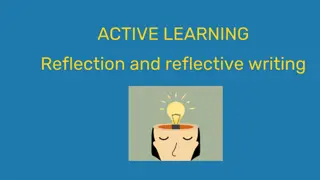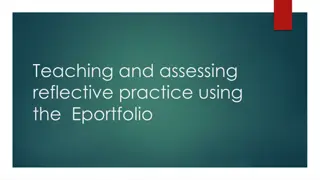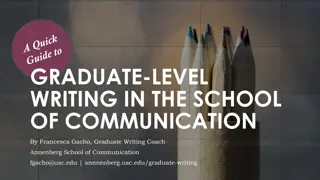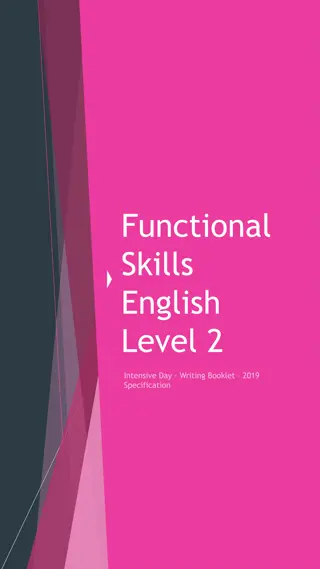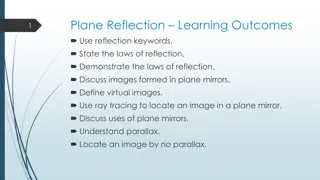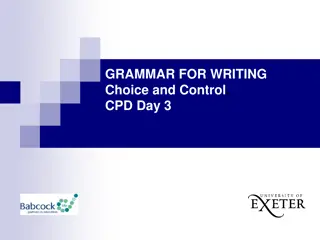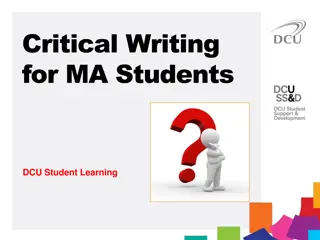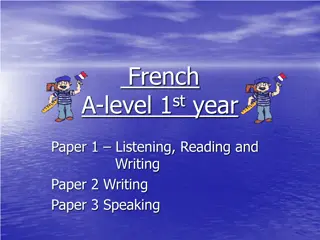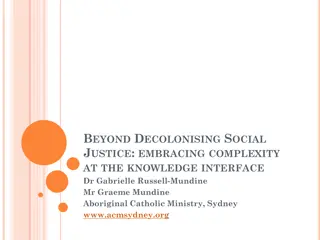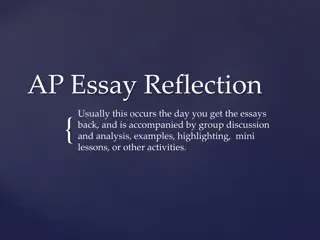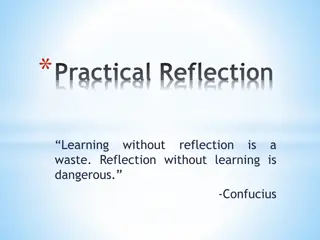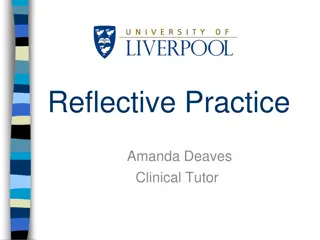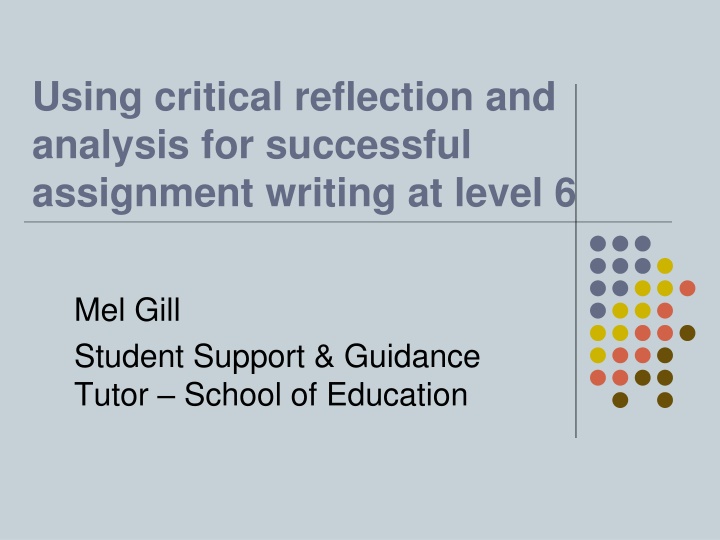
Advanced Assignment Writing Strategies: Critical Reflection and Analysis Level 6
Enhance your assignment writing skills at Level 6 by utilizing critical reflection and analysis. Learn to assess, synthesize, evaluate, and apply knowledge effectively for successful academic outcomes. Develop key skills such as analysis, synthesis, evaluation, application, and problem-solving to excel in your assignments.
Download Presentation

Please find below an Image/Link to download the presentation.
The content on the website is provided AS IS for your information and personal use only. It may not be sold, licensed, or shared on other websites without obtaining consent from the author. If you encounter any issues during the download, it is possible that the publisher has removed the file from their server.
You are allowed to download the files provided on this website for personal or commercial use, subject to the condition that they are used lawfully. All files are the property of their respective owners.
The content on the website is provided AS IS for your information and personal use only. It may not be sold, licensed, or shared on other websites without obtaining consent from the author.
E N D
Presentation Transcript
Using critical reflection and analysis for successful assignment writing at level 6 Mel Gill Student Support & Guidance Tutor School of Education
Level 4 - Support Level 5 - Choice Knowledge and Understanding Knowledge facts concepts terminology Ethical issues - awareness Cognitive and intellectual Skills Analysis using given principles with guidance Synthesis collecting ides in predictable format Evaluation reliability of data with guidance Application using given tools/methods Transferable Skills Group meets obligations to others Resources access range Self-evaluation against external criteria Managing information simple research tasks with guidance Communication - effective Problem-solving using given tools/methods Practical Skills Application- defined contexts Autonomy limited within defined guidelines as directed Knowledge and Understanding Knowledge variety of ideas contexts frameworks detailed theories Ethical issues wider social implications debate Cognitive and intellectual Skills Analysis compare alternative methods with minimum guidance Synthesis adapt format for purpose Evaluation relevance and significance of data Application choose appropriate tools/methods Transferable Skills Group interaction modifying responses Resources manage Self-evaluation develops own criteria Managing information select appropriate data Communication variety of formats Problem-solving choose appropriate tools/methods Practical Skills Application- variety of contexts Autonomy defined guidelines minimum guidance
Level Six Learner Critic Knowledge and Understanding Knowledge comprehensive knowledge specialisation provisional Ethical issues personal critical responsibility Cognitive and intellectual Skills Analysis without guidance uses appropriate techniques Synthesis transform data and concepts for purpose with minimum guidance Evaluation critically evaluate evidence Application confident flexible problem solver Transferable Skills Group leadership conflict management Resources professional minimum guidance Self-evaluation confident reflection against self-criteria seeks feedback Managing information competent research with minimum guidance Communication debate in professional manner Problem-solving confident and flexible Practical Skills Application unpredictable contexts Autonomy agreed guidelines minimum supervision critical responsibility
10% rise per level! If you got 63% for a piece of work at level 5 and produce work of the same academic level for a piece of work that should be at level 6 you can expect to gain a mark of 53%. So you need to raise your game by at least 10% just to maintain the same grade. Also, remember that the pass mark for level 6 is 40% and for level 7 it is 50%!
Moving forwards The aim is to achieve Autonomous Independent Active Critical reflection Comprehensive knowledge Appropriately referenced Contribution to a professional discourse
Independent Critical Reflection Observation and experience Reading Theory Context Critical Reflection Practice
Reference list building Be thorough Variety of resources/sources Keep a reading journal Never keep a quote without reference Keep a strict list De-select (edit) works you have not referenced at least indirectly Harvard system Brighton SoE guidelines
Levels of Reflectiveness (1) 1. Habitual action: providing material without any sense of the meaning. 2. Understanding: can demonstrate understanding but has difficulty applying it because it remains a theoretical concept and does not show how it might be used in practice.
Levels of Reflectiveness (2) 3. Reflection: can relate concepts and ideas to own experience, and writing is illustrated with examples from practice. 4. Critical reflection: this implies a change or transformation of perspective. Recognises own assumptions and can critically review them. Kember et al (2008)
Profound reflection: (Moon, 2001, pp.3-4) Is there relevant formal theory? Are there ethical / moral / wider social issues to explore? How are your perceptions of the issue present in your writing? Are there alternative interpretations or different points of view to consider? In what way(s) might you have tackled the task differently? If you step-back from this issue, does it look different? Are you aware of your feelings changing over time possibly in the course of writing?
Kolbs Experiential Learning Cycle Adapted from KOLB, D. (1984) Experiential Learning New Jersey: Prentice Hall Concrete Experience The Planning and Experimentation Personal Reflection Learning Cycle Critical Analysis
Academic key words Analyse: Examine in very close detail; identify important points and chief features. Critically evaluate: Weigh arguments for and against something, assessing the strength of evidence on both sides. Use criteria to guide your assessment of which opinions, theories or models are preferable. Describe: Give the main characteristics or features of something, or outline main events. Cottrell, S. (2013) The Study Skills Handbook (4th Ed) Macmillan Press: Basingstoke.
You need to...... Reference recent and relevant literature to build your arguments and support your claims Use your own experiences to additionally strengthen arguments and claims. Demonstrate critical reading, thinking, writing Assess the extent to which authors have provided adequate justification for the claims they make
Assignment Planner (2000 words) Intro - 200 words Ideas/points (relate to assessment criteria) References (theory/policy) Theme 1 500 words Theme 2 500 words Theme 3 500 words Conclusion 300 words
Critical reflection on Writing Structure Do sections relate chronologically or rhetorically (argument or narrative)? Development of argument Deductive reasoning from positions to cases (tendency to confirm) Inductive reasoning from cases to positions (tendency to explore without clear conclusion) Quotations Justification, persuasion, illustration
Proof-reading Sentences Length Variety of construction Syntactical function Verbs (please vary - they do nice things for meaning) Subject-verb agreement (is/are) Appropriate use of pronouns Expectations of use or non-use of subjective phrases (I feel/I think/I believe) Accuracy of expression rather than literary eloquence Punctuation The comma a case of neglect The apostrophe a victim of abuse Words Mixing up homonyms (their/there) Non-Standard forms of English ( It could of /It could have ) Their iz no excuzes for submiting werk with incorect speling... Spell-checkers University support Referencing see handbook/studentcentral
The importance of punctuation Punctuate this sentence correctly: A woman without her man is nothing
Punctuation changes meaning! A woman: without her, man is nothing. A woman, without her man, is nothing.
Incorrect use of commas He has lost interest in education, I feel frustrated by this. I ask him if he wants to give up smoking, his reply was no.
Importance of Proof Reading Aoccdrnig to rscheearch at Cmabrigde Uinervtisy, it deosn't mttaer in waht oredr the ltteers in a wrod are, the olny iprmoetnt tihng is taht the frist and lsat ltteer be at the rghit pclae. The rset can be a toatl mses and you can sitll raed it wouthit a porbelm. Tihs is bcuseae the huamn mnid deos not raed ervey lteter by istlef, but the wrod as a wlohe.
Grading criteria 60-69% A good response to the task: all learning outcomes have been met fully and many have been achieved at a good or very good standard. The work demonstrates all or most of the following characteristics in relation to those expected at the given level of study: A standard and comprehensive approach to the devising and/or execution of the work Very good understanding and exploration, some insight and/or thorough research No significant inaccuracies or misunderstandings Some high quality analysis, synthesis, evaluation, critical appraisal and/or performance The specifications for the assessment task, including word limit, have been adhered to. The work is well organised and the standard of presentation* is good.
Grading criteria: 40-49% level 6 50-54% level 7 An adequate, but weak, response to the task: all learning outcomes have been met but at least some barely exceed the threshold standard to pass the module. The work may display some strengths (such as those indicated in the characteristics of higher grades) but the grade is brought down by some weak features, such as: Very basic and/or poorly thought out approach to the devising and/or execution of the work Adequate but limited understanding and/or exploration of major ideas with very little insight and/or minimal research Some minor inaccuracies and/or misunderstandings The work is too descriptive, insufficiently analytical and/or poorly performed in relation to the expectations for the given level of study Some minor aberrations from the specifications for the assessment task Poor standard of presentation*
Showing thinking How can I know what I think until I see what I write? (Forster, 1927, p.6)
Showing thinking (referenced) Indirect Reference It has been said that writing makes unconscious thought evident to the writer (Forster, 1927.) Or Forster (1927) implies that writing makes unconscious thought evident to the writer. Direct Reference The complex relationship between language and thought takes many forms, How can I know what I think until I see what I write? (Forster, 1927, p6) Bibliographical acknowledgement Books Forster, E. M. (1927), Aspects of the Novel, London: Edward Arnold
Direct long quote Children also showed different ways of making sense of the reading process: Children in the study convincingly demonstrated that learning how tread bears the stamp of a person s individuality... Children in the study all exhibited likenesses in their physical, emotional and intellectual functioning. (Bussis et al, 1985, pp.64-5)
Referencing electronic sources Author or Editor or Corporate Author. (year), Title (edition)[online], Place of publication: Publisher. Available: <URL> [Access Date]. Eg: Herring, J. (1996) Teaching Information Skills in Schools [online], London: Library Association Publishing. Available:<URL:http://imdept.qmuc.ac.uk/imres/ books/JHbook1_a.htm> [Access date 20th November 2012].
Mels Studentcentral area Go to my school: education Scroll down pink box and click on SoE Student Support & Guidance See folder called, Useful information for successful assignment writing. And check out the Aspire Study Skills reading list.
What next? What do you need to do now to ensure that you are writing at the right level? Think about this for a moment and then share your thoughts with the person next to you.

